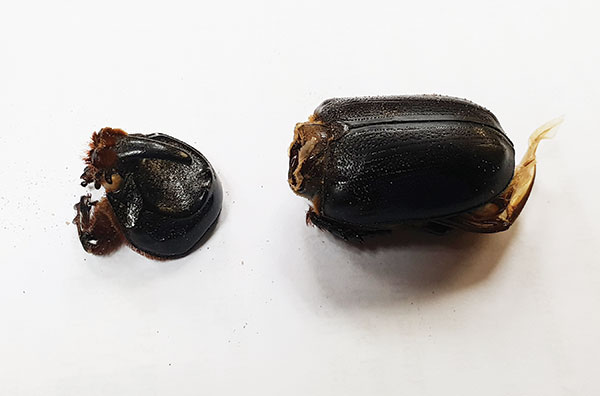DLNR: Rhino beetle found in Aguiguan

The Department of Lands and Natural Resource show a specimen of the coconut rhinoceros beetle that was reportedly found on Aguiguan in early October 2019.
(ERWIN ENCINARES)
The Department of Lands and Natural Resources confirmed that the carcass of a coconut rhinoceros beetle was found on Aguiguan, also known as the Goat Island, after social media posts circulated online.
DLNR Secretary Anthony Benavente confirmed with Saipan Tribune over the weekend that a group of hikers who recently visited Aguiguan found the dried-out body of a mature coconut rhino beetle on the island as they explored.
He noted that his office contacted the group of hikers, which reportedly consisted of four to five members, after photos surfaced online.
“They found the [remains of the beetle] on the ground [while resting]. …The group took it and brought it here [to Saipan]. They posted it on Facebook and reported it,” Benavente told Saipan Tribune in an interview.
The beetle had its head detached; the specimen that was already with Benavente included what is believed to be its detached head.
Following the report, Benavente noted that Tinian Mayor Edwin Aldan called DLNR to organize a trip to Aguiguan. The group, which would be composed of individuals trained on quarantining the coconut rhinoceros beetle, would set for the island sometime this week, Benavente said.
Saipan Tribune reached out to Aldan over the weekend but was unsuccessful.
Benavente said the team would be going toward the hiker group’s resting spot on the island, which he noted was specifically pinpointed by the group.
“We will be heading there [this week] with our Saipan team and Tinian teams to really determine if [the coconut rhino beetle] is there, because the [hiker group] found it. They only found a dead one,” Benavente said.
He noted that, according to Aldan, the group did not have permission to enter Aguiguan. Standard procedure would require special permission from the Tinian Mayor’s Office before anyone can set foot on Aguiguan. An email later sent to the Saipan Tribune contradicted this, with the writer saying they had a permit to hike on the island. An attachment to the email purported to show a permit that was signed by the Tinian mayor.
Coconut rhino beetles are nocturnal and breed on the coconut’s upper cone, killing the tree in the process. A female coconut rhino beetle can lay as much as 50 eggs and are considered a pest.



























